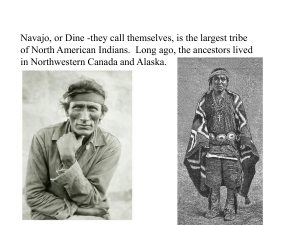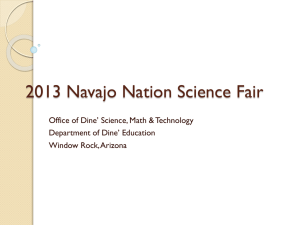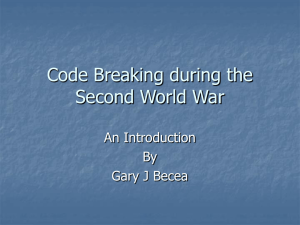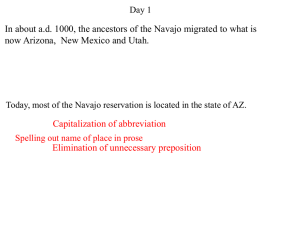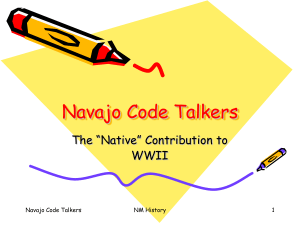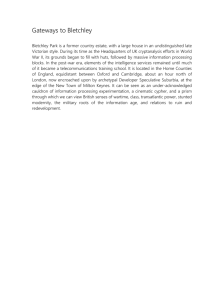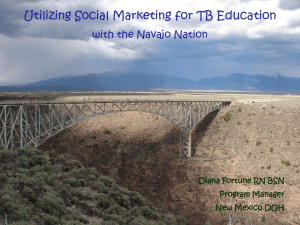code breakers and makers
advertisement
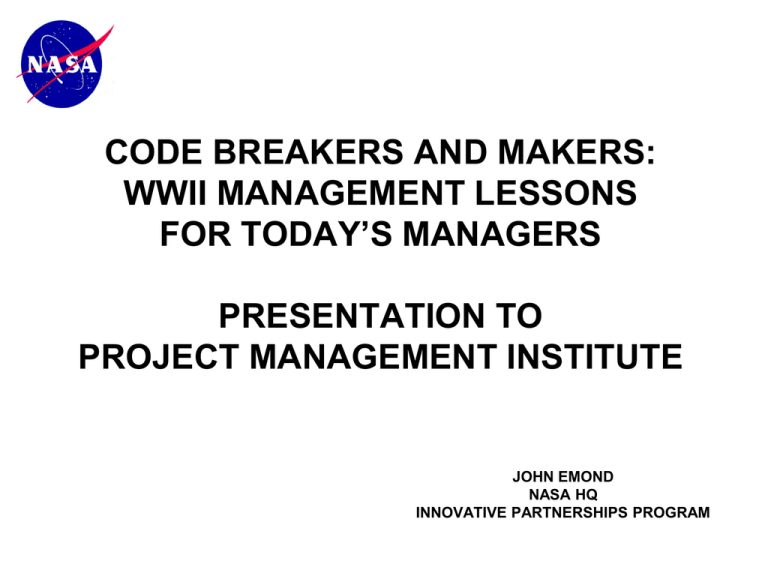
CODE BREAKERS AND MAKERS: WWII MANAGEMENT LESSONS FOR TODAY’S MANAGERS PRESENTATION TO PROJECT MANAGEMENT INSTITUTE JOHN EMOND NASA HQ INNOVATIVE PARTNERSHIPS PROGRAM PRESENTATION OUTLINE • CODES IN HISTORY • CODE BREAKING, CODE MAKING, WWII IMPORTANCE OF PROTECTING/CRACKING CODES BLETCHLEY PARK CODE BREAKERS AND THE GERMAN ENIGMA, LORENZ MACHINES NAVAJO CODE TALKERS/MAKERS • PROJECT MANAGEMENT THAT FOSTERED CODE BREAKER, CODE MAKER SUCCESS AND LESSONS FOR TODAY’S MANAGERS 2 ANCIENT CODES Disc of Phaistos Source: Wikipedia The disc of Phaistos was found in 1903 in the ancient city of Phaistos, southern Crete and is believed to date to ~1700 B.C. Several reference sources indicate the meaning of its symbols remains unknown. 3 17TH CENTURY CODE Written August 31, 1645. • Prince Maurice to Lord Digby; both senior commanders in armies of Charles I. • Much of code remains a mystery but enough is known that the message regards Royalist town of Hereford about to be attacked by Parliament forces during English Civil War. 4 (Source: U.K. National Archives) AMERICAN REVOLUTION AMERICAN TRAITOR July 12, 1780 -- Benedict Arnold to British Major John André (Code) I 293.9.7 to C_t. B. 103.8.2. the 7th 152.9.17. that , a F__ 112.9.17. and 22.8.29 were 105.9.50 to / 4 9.71 in 62.8.20 with , 163.8.19 A 22.8.19 at with 230.8.13. 263.8.17 I gave Mr. S--y a 164.8.16 / 147.8.261 to be 209.9.216 in C----a and have from 163.8.17 to .163.8.17 .58.8.27 to him. / Such 147.8.21 as I 164.9.5 147.9.16 s which he 24.9.125 me has 169.9.23'd to you / I 129.8.7 .46.9.22'd no 19.8.29 to 175.9.17 . 158.8.8 - or any 177.8.13 . 168.9.13 . ------- / I 105.9.5. soon to 57.9.7 .at 288.9.8 , 198.9.26, and most . 230.8.12. by --- / 291.8.27 an 149.8.27 with ---255.9.11 . 148.8.22, 182.4.28 in whom a 175.9.12 / 67.8.28 could be .196.9.16 --- the 177.8.8 is .103.8.19 to 22.9.3, and / to 66.8.15 -- are 182.8.28, 169.8.25 be . 260.8.5 , 205.9.3 near / that 209.9.18. --- and 192.9.9'd to 224.9.9 on ,188.8.13 or some ---- / 182.8.28 on 188.8.13 sent 185.6.24 to 95.9.124 an .104.8.1 120.9.7, W------- 105.9.5's on the .22.9.14.---- / of 163.8.19 F---- 172.8.7s to 56.9.8 |30.000| 172.8.70 to 11.94. in / 62.8.20. If 179.8.25, 84.8.9'd, 177.9.28. N---- is 111.9.27.'d on / 23.8.10. the 111.9.13, 180.9.19 if his 180.8.21 an .179.8.25., 255.8.17. for / that, 180.9.19, 44.8.9 --a-- is the 234.8.14 of 189.8.17. I --/ 44.8.9, 145.8.17, 294.9.12, in 266.8.17 as well as, 103.8.11, 184.9.15.---- / 80.4.20. ---- I149.8.7, 10.8.22'd the 57.9.71 at 288.9.9, 198.9.26, as, a / 100.4.18 in 189.8.19-- I can 221.8.6 the 173.8.19, 102.8.26, 236.8.21's--- / and 289.8.17 will be in 175.9.7, 87.8.7--- the 166.8.11, of the .191.9.16 / are .129.19.21 'of --- 266.9.14 of the .286.8.20, and 291.8.27 to be an ---163.9.4 / 115.8.16 -'a .114.8.25ing --- 263.9.14. are 207.8.17ed, 125.8.15, 103.8.60--- / from this 294.8.50, 104.9.26 -- If 84.8.9ed -- 294.9.12, 129.8.7. only / to 193.8.3 and the 64.9.5, 290.9.20, 245.8.3 be at an, 99.8.14 . / the .204.8.2, 253.8.7s are 159.8.10 the 187.8.11 of a 94.9.9ing / 164.8.24, 279.8.16, but of a .238.8.25, 93.9.28. From the Clinton Collection, Clements Library 5 AMERICAN REVOLUTION AMERICAN TRAITOR July 12, 1780 -- Benedict Arnold to British Major John André (Selected Deciphered Passages) I wrote to Captn B[eckwith]-on the 7th of June, that a F[rench]--- fleet and army / were expected to act in conjunction with the A[merican]--- army. - I expect soon / to command W[est] P[oin]t and most seriously wish an interview with some / intelligent officer in whom a mutual confidence could be placed. • • I have accepted the command at W[est]. P[oint]. As a Post in which / I can render the most essential Services, and which will be in my disposal. / The mass of the People are heartily tired of the War, and wish to be on / their former footing They are promised great events from this / year's exertion -- If - disappointed - you have only to persevere / and the contest will soon be at an end. • As Life and fortune are risked by serving His Majesty, it is / Necessary that the latter shall be secured as well as the emoluments / I give up, and a compensation for Services agreed on and a Sum / advanced for that purpose - which I have mentioned in a letter / which accompanies this, which Sir Henry will not, I believe, think / unreasonable. 6 From the Clinton Collection, Clements Library AMERICAN REVOLUTION AMERICAN TRAITOR July 12, 1780 -- Benedict Arnold to British Major John André (Deciphered) I wrote to Captn B[eckwith]-on the 7th of June, that a F[rench]--- fleet and army / were expected to act in conjunction with the A[merican]--army. At the same time / I gave Mr. S[tansbury]-a manifesto intended to be published in C[anad]---a, and have / from time to time communicated to him such intelligence as I thought / interesting, which he assures me he has transmitted to you. I have / received no answer from my Letter, or any verbal Message - I expect soon / to command W[est] P[oin]t and most seriously wish an interview with some / intelligent officer in whom a mutual confidence could be placed. The / necessity is evident to arrange and to cooperate - An officer might / be taken Prisoner near that Post and permitted to return on parole, / or some officer on Parole sent out to effect an exchange. General W[ashington]--- expects on the arrival of the F[rench]--Troops to collect / 30,000 Troops to act in conjunction; if not disappointed, N[ew]. York is fixed / on as the first Object, if his numbers are not sufficient for that Object, / Can-a- is the second; of which I can inform you in time, as well as of / every other design. I have accepted the command at W[est]. P[oint]. As a Post in which / I can render the most essential Services, and which will be in my disposal. / The mass of the People are heartily tired of the War, and wish to be on / their former footing - They are promised great events from this / year's exertion -- If - disappointed - you have only to persevere / and the contest will soon be at an end. The present Struggles are / like the pangs of a dying man, violent but of a short duration--As Life and fortune are risked by serving His Majesty, it is / Necessary that the latter shall be secured as well as the emoluments / I give up, and a compensation for Services agreed on and a Sum / advanced for that purpose - which I have mentioned in a letter / which accompanies this, which Sir Henry will not, I believe, think / unreasonable. I am Sir, your humble Servant. / July 12, 1780 J. Moore / Mr. Jn Anderson / P.S. I have great confidence in the Bearer, but beg Sir Henry / will threaten him with his resentment in case he abuses the con- / fidence placed in him, which will bring ruin on me. / The Bearer will bring me 200 Guineas, and pay the remainder to / Captn A----- who us requested to receive the deposit for Mr. Moore From the Clinton Collection, Clements Library 7 AMERICAN CIVIL WAR Confederate Encoding Disc Source: U.S. Naval Landing Party.org 8 “OLD…AND NEW….” Disc of Phaistos, Confederate Encoding Disc 17th century…B.C. 19th century A.D. 9 ENGLISH CODE BREAKERS NAVAJO CODE MAKERS WWII 10 OUTBREAK OF WAR: EUROPE • Sept 1, 1939 - Nazis invade Poland. • Sept 3, 1939 - Britain, France, Australia and New Zealand declare war on Germany. • Sept 10, 1939 - Canada declares war on Germany; Battle of the Atlantic begins. • Sept 17, 1939 - Soviets invade Poland. • April 9, 1940 - Nazis invade Denmark and Norway. • May 10, 1940 - Nazis invade France, Belgium, Luxembourg, Netherlands; Holland surrenders May 15 • May 28, 1940 - Belgium surrenders to the Nazis. • June 3, 1940 - Germans bomb Paris; Dunkirk evacuation ends • June 10, 1940 - Norway surrenders to the Nazis; Italy declares war on Britain and France. • June 14, 1940 - Germans enter Paris; June 22, 1940 - France signs an armistice with the Nazis • July-October, 1940- Air War, Battle of Britain • June 22, 1941- Germany Invades Russia 11 OUTBREAK OF WAR: ASIA • December 7, 1941 - Japanese bomb Pearl Harbor, Hawaii; also attack the Philippines, Wake Island, Guam, Malaya, Thailand, Shanghai and Midway. • December 8, 1941 - U.S. and Britain declare war on Japan. China declares war on Japan December 9, 1941. • December 10, 1941 - Japanese invade the Philippines and also seize Guam; invade Burma December 11. • December 16, 1941 - Japanese invade British Borneo; invade Hong Kong on December 18.. • December 23, 1941 - General MacArthur begins a withdrawal from Manila to Bataan; Japanese take Wake Island. • December 25, 1941 - British surrender at Hong Kong. • January 7, 1942 - Japanese attack Bataan in the Philippines. • February 8/9 - Japanese invade Singapore; February 15, 1942 - British surrender at Singapore. • April 3, 1942 - Japanese attack U.S. and Filipino troops at Bataan; April 9, 1942 - U.S. forces on Bataan surrender unconditionally to the Japanese. • April 10, 1942 - Bataan Death March: 76,000 Allied POWs including 12,000 Americans forced to walk 60 miles under a blazing sun, no food/water, to POW camp; over 5,000 American deaths. • May 6, 1942 - Japanese take Corregidor as Gen. Wainwright unconditionally surrenders all U.S. and Filipino forces in Philippines. 12 GLOBAL WAR ON MANY FRONTS In addition to a clash of armies, WWII was a clash of minds. Codes protected battle plans and strategies, Code breakers tried to unlock the keys to such plans 13 CODE BREAKERS 14 GERMANY’S “ENIGMA” MACHINE • Enigma machine electro-mechanical device, relies on a series of rotating 'wheels' or ‘rotors’ to scramble plain text messages into incoherent ciphertext. • The machine's variable elements set in many billions of combinations; each one generates a completely different ciphertext message. • Knowledgeable operators type the ciphertext back in to unscramble the message; otherwise if the Enigma setting is not known, message remains indecipherable. • Available commercially in the 1920’s, German military adapted the Enigma machine to protect military communications Source: Bletchley Park National Codes Center 15 Invention, counter-invention The English developed their own machinery to help crack the code. • “Bombe” developed building on Polish crypto-analyst efforts passed to British at start of war; Enigma code broken by 1940. Enigma Bombe Lorenz Colossus • “Lorenz” even more complicated in code formation than Enigma, used by the German High Command • To crack “Lorenz”, British built “Colossus”, forerunner to modern computers Used 1,500 vacuum tubes; read tape @5,000 characters per second. Colossus delivered to Bletchley Park in 1943, upgraded in June,1944 in time to verify Germans deceived regarding D-Day invasion site Normandy, France, June 6, 1944. 16 Source: Bletchley Park National Codes Center CODE BREAKING: BLETCHLEY PARK, 50 miles north of London 17 BLETCHLEY PARK • The "first wave" of the Government Code and Cypher School (GC&CS) moved to Bletchley Park on August 15, 1939. • Listening stations around England, “Y” Stations, gathered raw signals for processing at Bletchley. • Coded messages taken down by hand, sent to Bletchley on paper by motorcycle couriers or, later, by teleprinter. • Technology advances such as “Colossus” enabled hundreds of encrypted messages deciphered each day by mechanical calculation. 18 BLETCHLEY PARK, THE HUMAN ELEMENT • 9,000 people worked at Bletchley Park by 1945 • Human resources were rich and varied: Apart from brilliant mathematicians such as Alan Turing, Bletchley Park was diverse community: Electrical Engineer Poet School Teacher Novelist Chess champions Crossword puzzle experts…ability to solve “The Daily Telegraph” crossword in under 12 minutes used as a recruitment test; winner did it in under 8 minutes 19 CODE MAKERS Source: U.S. Mint 20 NAVAJO CODE TALKERS • At outbreak of WWII, U.S. had difficulty in devising a protected code In Pacific theater, Japanese code-breakers, some who had lived in U.S. and were proficient in English including slang, were able to decipher or intercept/sabotage American transmitted commands and information. • As a son of a Protestant missionary, Philip Johnston, a WWI Marine vet, grew up with Navajo children and learned their language and customs. • In 1942 Johnston read a newspaper account of Louisiana code military communications staff trying to use Native American personnel for code development. He presented his idea of using Navajo to Lt. Col. James Jones, Area Signal Officer, Camp Elliot near San Diego. 21 NAVAJO CODE TALKERS • Until just prior to WWII, the Navajo language was never written or translated, therefore fully self-contained, insulated. • 29 Navajo Indians were trained as code talkers Encode, transmit and decode a 3-line English message in 20 seconds. Machine translations took 30 minutes • Many Navajo code-talkers had never been away from reservation. 2 were left behind to train others; Remainder sent to Guadalcanal (campaign August 7, 1942-February 1943) to try the code in combat. • Served in six Marine divisions, Marine Raider battalions, and Marine parachute units. • Navajo code-talkers took part in every assault in the Pacific, from 1942 to 1945 including Tarawa, Saipan, Iwo Jima, and Okinawa • By war’s end, original 29 grew to 450 Navajo code talkers » Source for information: www,americanindians.com 22 NAVAJO WRITTEN LANGUAGE, STANDARDIZED ALPHABET ESTABLISHED 1939 Source: Earthlink.net 23 Navajo Code Talkers' Dictionary REVISED AS OF 15 JUNE 1945, DECLASSIFIED Source: Department of the Navy, Naval Historical Center WORD NAVAJO WORD Corps Battalion Squad Commanding General Colonel Dive Bomber Observer Plane Fighter Plane Battleship Concentration Halt Hostile Mine Navy Ordnance Radar Scout Tank DIN-NEH-IH TACHEENE DEBEH-LI-ZINI BIH-KEH-HE ATSAH-BESH-LE-GAI GINI NE-AS-JAH DA-HE-TIH-HI LO-TSO TA-LA-HI-JIH TA-AKWAI-I A-NAH-NE-DZIN HA-GADE TAL-KAH-SILAGO LEI-AZ-JAH ESAT-TSANH HA-A-SID-AL-SIZI-GIH CHAY-DA-GAHI LITERAL TRANSLATION Clan Red Soil Black Sheep War Chief Silver Eagle Chicken Hawk Owl Humming Bird Whale One Place Halt Not Friendly Mine Sea Soldier Under Ground Listen Short Racoon Tortoise 24 NAVAJO CODE TALKERS Source: National Archives Photo Records Ballart, South Pacific, July 7, 1943 Corporal Lloyd Oliver operates a field radio as part of Marine Artillery Regiment, South Pacific. He was also a Sniper and scout. Bougainville, December, 1943 Corporal Henry Bahe, Jr,. Private George Kirk, with a Marine Signal Unit 25 CODE-BREAKERS/CODE MAKERS PROJECT MANAGEMENT, LESSONS FOR TODAY 26 High Risk/High Rewards Code-Breaking • • Failure to crack code, or discovery of efforts by enemy, could have greatly increased battle casualties, possibly determine war’s outcome Success meant dramatic benefits Advance knowledge of Luftwaffe’s English targets, 1940 Battle of Britain Interdicting German U-Boat “Wolf-Packs” preying on Allied shipping Interdicting German Afrika Korps ship convoys, North African campaign Cracking Lorenz code verified Germans were deceived about D-Day invasion site Code-Making • • Failure to protect the code would have exposed many thousands of American Marines to even greater danger than they faced Success: Like fire prevention that stops an event from occurring, full success of Navajo code-talkers protecting vital information may never be known. But according to a quote (AmericanIndians.com) from Major Howard Connor, 5th Marine Division signal officer, “were it not for the Navajos, the Marines would never have taken Iwo Jima”. 27 6 Navajo code-talkers worked around the clock during the first 48 hours of battle on Iwo Jima. 800 messages sent and received without error. High Risk/High Rewards • Code Breaker/Code Maker success in WWII was dramatic but clandestine; remained classified decades after end of WWII • NASA missions often dramatic, high risk, high reward and in the public eye as the agency’s mission and mandate is to broadly disseminate its goals and objectives. Tragedies and triumphs are seen by the world • In varying degrees we all encounter opportunities that pose both risks, and rewards 28 LESSONS LEARNED FOR NASA AND OTHER ORGANIZATIONS CREATIVITY AND INCLUSION • Code breakers at Bletchley drawn from diverse backgrounds beyond intelligence and/or scientific community, to ensure a range of approaches. Non-conventional, non-military backgrounds: poets with linguistic abilities, puzzle and chess experts on pattern recognition, to help crack “Enigma”, “Lorenz” • NASA missions involving modeling and simulation draw on men and women who grew up on computer simulation games, much like Bletchley staff used crossword puzzle experts to explore cypher code formation. 29 LESSONS LEARNED FOR NASA AND OTHER ORGANIZATIONS CREATIVITY AND INCLUSION • Navajo Indian culture and language used to create unbreakable code Unique linguistic skills, not military experience, was key • NASA “Astronaut Glove” Centennial Challenge 2007 winner, Peter Homer Competition encouraged creative approaches to improved glove design Peter Homer’s background of aerospace and sailing/sail making Constructed glove included off the shelf materials; glove made on kitchen table Source: SPACE.com/T.Malik 30 LESSONS LEARNED FOR NASA RISING TO MEET THE CHALLENGE • To meet challenge of “Lorenz”, greatly more complicated than “Enigma”, British designed “Colossus”, a forerunner to the current computer. • To develop a system that could create effective, protected code, a dictionary of English/Navajo terms was developed for a language that had never used the written word. Adaptation of military terms to meet Navajo language and culture and further protect the original meaning of the encoded message. • In NASA’s evolution from “sortie” missions in Low Earth Orbit, to a crewed International Space Station and long-duration habitation, long range exploration missions, the agency faces many challenges including the fields of: Life sciences: adaptation to variable gravity environments, radiation mitigation, telemedicine, sustainable sources of water and food, meeting psychological and physical stress factors of long duration in remote closed environment systems etc., Advance material development Energy conservation and production Propulsion, including development of advance spacecraft In-situ resource utilization 31 LESSONS LEARNED CODE BREAKER/CODE MAKER PROJECT LEADERSHIP TRUSTED NON-CONVENTIONAL APPROACHES AND DIVERSE HUMAN RESOURCES DURING A TIME OF GLOBAL WARFARE • Conglomeration of skills and background at Bletchley Park, all under strict security conditions. • Use of Navajos to rapidly develop unbreakable encode and decode system even though written language was non-existent a few years before the war. • Given the crucial role of protecting “intellectual property”, in this case the code breakthrough of Enigma and Lorenz, or the protection of the Navajo code talker system, project leadership placed a great deal of trust in the participant communities. That trust was maintained; the code breaker and code maker secrets protected from disclosure for decades after the war’s end. 32 CONCLUSION • WWII code breakers, code makers part of timeless struggle Information disclosure or protection goals as relevant to ancient symbols on discs, as 21st century software and “hackers”. • To meet the challenges of a world at war, leaders encouraged every possible creative mind tapped: Unique attributes such as Navajo oral culture and language Eclectic skills combining English mathematicians and engineers, with poets, teachers, puzzle and chess experts to encourage diverse approaches in meeting a common challenge. • NASA’s future missions will not be based on dire combat for survival, and NASA’s mandate is to broadly disseminate its goals. But magnitude of missions, including human exploration of and habitation in other planets, and advancing broad fields of scientific discovery, require the same level of commitment and determination to: Meet challenges known and encountered, at design stage or mission real-time 33 Broadly use, trust creative, dedicated talents of a wide and diverse community John Emond Innovative Partnerships Program NASA Headquarters john.l.emond@nasa.gov www.ipp.nasa.gov 202-358-1686 34
